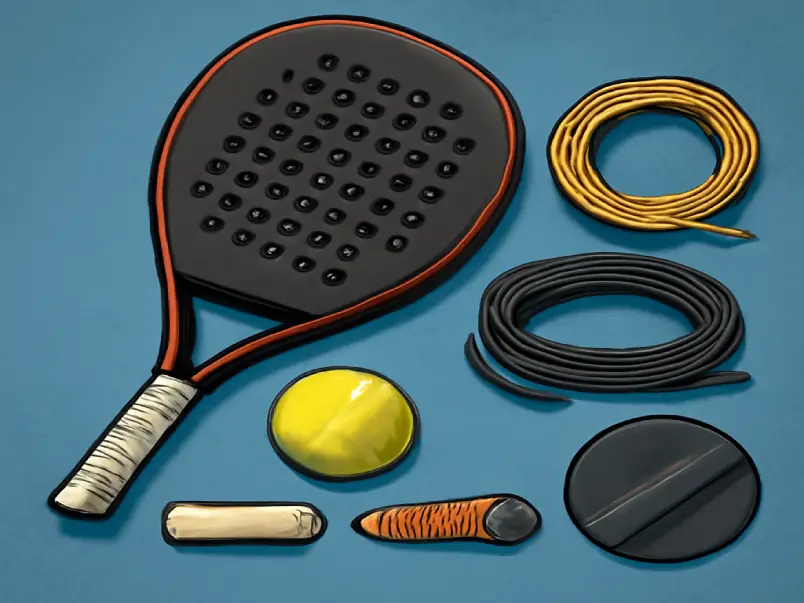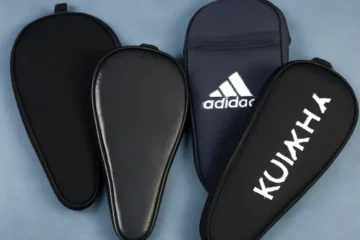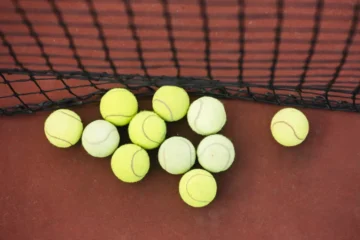Padel, a sport that combines the thrill of tennis and the finesse of squash, has taken the world by storm. Whether you’re playing for fun or competing in intense matches, the right equipment is key to success. Among the various factors that influence your performance, one of the most underrated but crucial elements is the string of your padel racket. While the racket frame certainly plays a role, the strings are the unsung hero of your game. They are the point of contact with the ball, and their impact on control, power, comfort, and durability cannot be overstated.
Choosing the best padel strings, whether you’re after control or power, can significantly affect your playing style and performance. In this guide, we’ll break down how padel strings influence your game, explore key string characteristics, and provide tailored recommendations for both control-oriented and power-oriented players. Whether you’re a tactical strategist or an aggressive attacker, we’ve got the right strings for you.
The Unsung Hero of Your Padel Racket
Imagine this: You’ve invested in a top-quality padel racket, but something still feels off. Your shots lack precision, or perhaps you’re not generating enough power. If this sounds familiar, the issue may lie in your choice of strings. While players often focus on the frame, the strings are the ones that make the direct impact on your game. They are the ultimate interface between your racket and the ball, and their properties—such as tension, material, and gauge—can influence your style and performance.
This guide aims to help you understand the nuances of padel strings and assist you in making an informed decision based on your preferred playing style. We’ll examine the key differences between control and power strings and offer our top recommendations for both types of players.
Part 1: Understanding Padel Strings – The Basics
1.1 What Are Padel Strings Made Of?
The material composition of your padel strings can make a significant difference in terms of feel, durability, and performance. The three main types of padel strings are:
Monofilament (Nylon):
Monofilament strings are the most common choice in padel. These strings are made from a single strand of material, typically nylon or polyester, and offer a solid balance between durability, comfort, and performance. The stiffness of monofilament strings can be adjusted, allowing for both control and power, depending on the gauge and tension used.
Multifilament:
Made from many thin fibers twisted or woven together, multifilament strings are designed to provide superior comfort and power. These strings absorb more shock and vibrations, making them an excellent choice for players who want a softer feel. However, they tend to wear out faster than monofilament strings, making them less durable.
Natural Gut:
The gold standard for tennis strings, natural gut offers exceptional power and feel. However, it is rarely used in padel because it is expensive, vulnerable to changes in humidity, and doesn’t stand up well against the abrasive surfaces of padel courts. While it offers outstanding playability, it’s not commonly found in the padel market.
1.2 Key String Characteristics That Affect Your Game
The following factors play a pivotal role in shaping your playing experience:
Density (Open vs. Closed Pattern):
The string pattern of your racket, whether open or closed, affects the level of control and spin you can generate. An open string pattern offers more spin potential but sacrifices control, while a closed pattern offers greater control at the expense of spin.
Gauge (Thickness):
The thickness of the strings, measured in millimeters, also plays a vital role. Thinner strings (e.g., 1.25mm) are more elastic, offering greater power and feel, while thicker strings (e.g., 1.35mm) provide more control and durability.
Shape (Texture):
String texture can enhance the spin you generate. Rough or textured strings grip the ball better, allowing you to create more spin, whereas smooth strings provide a more consistent, controlled response with less spin.
Hardness/Softness:
The hardness or softness of a string affects both its power and comfort. Softer strings absorb more shock, which provides more comfort and power but less control. Harder strings, on the other hand, provide a crisper, more responsive feel, favoring control.
Part 2: The Control Player’s Arsenal
Who is a Control Player?
A control player is all about precision. They tend to focus on shot placement, angle, and finesse rather than brute strength. Control players rely on their racket’s feel and consistency, prioritizing accuracy over power. Their shots are deliberate, using a well-placed lob, drop shot, or angled shot to outmaneuver their opponents.
What to Look For in a Control String
For control players, the ideal string should offer:
- Thicker Gauge (e.g., 1.30mm – 1.35mm): Thicker strings provide more control and durability.
- Harder Feel: Harder strings are stiffer, offering a more precise feel and better shot accuracy.
- Tighter Weave Pattern: A tightly woven string pattern enhances control by reducing string movement.
- Smooth Surface: A smooth surface promotes a consistent response when hitting the ball, ensuring more control.
Top Padel String Recommendations for Control
- Siux Neon Hybrid 1.30:
This hybrid string combines a hard monofilament main string with a softer cross string, providing the perfect balance of control and comfort. Ideal for all-around control players, this string allows for precise shot-making without sacrificing comfort. - Bullpadel Vertex Control 1.33:
Designed specifically for control players, this string offers a thicker gauge and a firm, responsive feel. The Vertex Control string excels in offering maximum precision for players who prefer to dominate the court with their placement and angles. - Head Padel Pro String 1.30:
A durable, high-precision monofilament string, the Head Padel Pro string is known for its consistent performance and excellent feel at the net. This string is a great choice for control players who demand the utmost precision in every shot.
Honorable Mention:
Drop Shot Caiman Control 1.30: Known for its superior control and comfort, this string offers excellent precision while providing great durability.
Part 3: The Power Player’s Toolkit
Who is a Power Player?
Power players are the aggressors on the padel court. They rely on strength, speed, and explosive shots to overpower their opponents. Whether they’re smashing the ball with a bandeja or blasting a flat shot down the line, power players favor strings that provide maximum ball speed and energy return.
What to Look For in a Power String
For power players, the ideal string should offer:
- Thinner Gauge (e.g., 1.25mm – 1.28mm): Thinner strings offer more elasticity, creating more power and ball speed.
- Softer Feel: Softer strings allow for greater shock absorption, giving you more power with less strain on your arm.
- Rough Texture: A textured surface allows for more spin, adding to the aggressiveness of the shot.
Top Padel String Recommendations for Power
- Siux Magnesium 1.25:
Favored by many attacking pros, this string is incredibly soft and elastic, offering outstanding power and ball output. It’s a perfect choice for power players who need a string that helps them generate explosive shots. - Bullpadel Hack Power 1.25:
This string features a unique hexagonal structure that maximizes both power and spin. Perfect for players who often go for big smashes, the Hack Power 1.25 helps deliver power-packed shots with excellent spin potential. - Adidas Padel Speed 1.25:
A soft, responsive string that blends power and comfort, the Adidas Padel Speed 1.25 is perfect for power players looking to generate explosive shots with minimal strain on the arm.
Honorable Mention:
Black Crown Panther 1.25: Known for its impressive power and durability, this string is ideal for players who want maximum speed without sacrificing comfort.
Part 4: The Hybrid Approach: The Best of Both Worlds?
What is a Hybrid Setup?
A hybrid setup involves using two different types of strings in your racket: a harder string in the mains (vertical strings) for control and a softer, power-oriented string in the crosses (horizontal strings) for added comfort and power.
Common Hybrid Strategy
A common hybrid setup might involve a monofilament string in the mains for control and a multifilament or soft string in the crosses for comfort and power. This hybrid approach allows players to enjoy the benefits of both worlds—control and power—without sacrificing one for the other.
Pros & Cons
- Pros:
A hybrid setup can provide the perfect balance of control and power. It allows for a more personalized feel and can help mitigate the weaknesses of single-string setups. - Cons:
Hybrid strings are more expensive, and the setup can be more complex, requiring players to experiment with different combinations to find the best balance.
Part 5: Beyond Control vs. Power – Other Crucial Factors
While the control vs. power debate is important, there are other factors to consider when selecting your padel strings.
Durability
Control strings tend to be thicker and harder, which makes them more durable. Power strings, on the other hand, are generally thinner and softer, meaning they wear out more quickly. If you’re an aggressive player who plays frequently, you might want to prioritize durability to avoid frequent string breakage.
Comfort & Arm-Friendliness
Softer strings provide more comfort by absorbing shock and reducing vibration, which can help prevent injuries such as tennis elbow. If you have arm issues or play for long hours, consider strings designed with comfort in mind.
Tension
String tension plays a key role in how your racket performs. Lower tension generally provides more power, while higher tension gives you more control. Consult a professional stringer to get the best tension for your playing style.
Conclusion: Stringing It All Together
Choosing the right padel strings can have a profound impact on your performance. For control players, thicker, harder strings offer precision and accuracy, while power players benefit from thinner, softer strings that generate explosive shots. Don’t be afraid to experiment with different string types, gauges, and tensions to find what suits your playing style best.
At the end of the day, it’s not just about the racket or the strings—it’s about the perfect synergy between the two, tailored to your unique game.
FAQs
What is the difference between control and power padel strings?
Control padel strings tend to be thicker, harder, and offer greater precision, making them ideal for players who focus on placement and finesse. Power padel strings are generally thinner, softer, and offer more elasticity, allowing players to generate explosive shots and speed.
What is the best padel string for control players?
The best padel strings for control players typically have a thicker gauge (around 1.30mm-1.35mm), a hard feel, and a smooth surface for consistent ball contact. Popular options include Siux Neon Hybrid 1.30, Bullpadel Vertex Control 1.33, and Head Padel Pro String 1.30.
What is the best padel string for power players?
For power players, thinner, softer strings in the 1.25mm-1.28mm range are ideal. These strings provide more elasticity, helping to generate explosive shots. Some top recommendations are Siux Magnesium 1.25, Bullpadel Hack Power 1.25, and Adidas Padel Speed 1.25.
What are hybrid padel strings?
A hybrid setup uses two different types of strings: a harder, control-oriented string in the mains (vertical strings) and a softer, power-oriented string in the crosses (horizontal strings). This combination allows players to enjoy both control and power benefits.
How do string tensions affect padel performance?
String tension impacts your racket’s performance. Lower tension provides more power, while higher tension offers more control. Players should consult a professional stringer to adjust the tension based on their playing style.
Which padel string material is the most durable?
Monofilament strings made from nylon or polyester tend to be the most durable option. These strings are less prone to wear and tear compared to multifilament strings, making them ideal for frequent players.
Do power strings hurt your arm?
Softer, power-oriented strings absorb more shock and vibrations, reducing the strain on your arm and preventing injuries like tennis elbow. However, players should consider their playing style and comfort needs when choosing strings.




